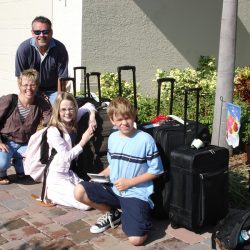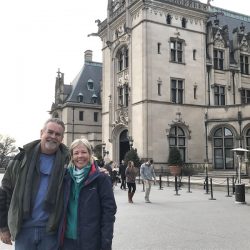25 Days of Christmas – Day 14: Epcot’s Holiday Storytellers
Canada
From the waterways of eastern Newfoundland to the snow-capped mountains of British Columbia, the Christmas holidays hold special magic for the vast expanse of Canada.
Although favorite traditions such as awaiting Santa Claus, or le Pere Noel, trimming the evergreen, and singing Christmas carols are similar to those commonly found in the United States and Europe. Canada has many unique holiday traditions as well.
In some traditional Canadian homes, Santa Claus enlists the help of devilish creatures called Belsnickles to determine which children have been “naughty or nice.” The Belsnickles supposedly enter the homes of naughty boys and girls to cause mischief.
Even Canada’s Inuit children are visited by mysterious creatures called Naluyuks who travel from house to house. The children mush sing Christmas carols to appease the Naluyuks, who pound sticks on the floor before the question the children about their behavior. When the children say they’ve been good, which they always do, the Naluyuks open special gift bags full of wonderful presents.
In. Quebec, le reveillon, a sumptuous traditional French dinner is served after Midnight Mass on Christmas Eve.
Most of Canada celebrates Boxing Day on December 26, in honor of the ancient English tradition of giving filled Christmas boxes to the poor as well as to servants and tradesmen for their help during the year.
Nowell the Lumberjack
[nggallery id=1]
United Kingdom
Many wonderful Christmas traditions originated in the countries of the United Kingdom. Great Britain, Northern Ireland, Scotland and Wales. Each have unique holiday customs, and many of these have been shared worldwide. Well-known Christmas carols such as “Deck the Halls” and Here We Come a Wassailing” were first sung in the United Kingdom.
The tradition of Christmas cards also began in the United Kingdom. In 1843, John Calcott Horsley sent a card depicting an English family brimming with cheer to his friend Sir Henry Cole. The original card caught the attention of a British giftbook company, which published a thousand lithographed copies and sold them for a shilling each.
Not surprisingly, the hanging of mistletoe is one of the United Kingdom’s oldest and most popular traditions, dating back to the Druidic ceremonies of the winter solstice. Each time a kiss was claimed under the mistletoe, the young man would pick off one berry. The kissing would end when all the berries were gone!
For children, Father Christmas, with his long white beard, green robe, and crown of holly, is still treasured as the jolly gift-bearer who brings holiday joy to the well-behaved.
Father Christmas
[nggallery id=2]
France
The magic of Christmas can be seen everywhere in France. The shops and baraques, or booths, along the beautiful boulevards are brimming with toys, glittering lights, and Christmas decorations of every imaginable kind.
Children eagerly await le Pere Noel (Father Christmas), who arrives on Christmas Eve to deliver wonderful presents. Most churches and homes display a beautiful nativity scene called a creche, which is considered on of the most important symbols of Christmas to the French. Traditionally, candles are lit around the creche: sometimes a special Yule log is also burned on the fire.
After families return from Midnight Mass, they enjoy the feast called le reveillon, which often consists of ham, goose, oysters, salads, cheese, champagne, and Buche de Noel, a delicious chocolate cake shaped like a Yule Log.
Children then set out shoes around the Christmas tree in great anticipation of le Pere Noel who fills them with all sorts of goodies!
Pere Noel
[nggallery id=3]
Morocco
Two major holidays of Morocco are Eid al-fitr and Eid al-Adha.
One of Morocco’s holiest celebrations is the month of Ramadan, which commemorates the month in which Allah revealed to the Muslin People, the Holy book, The Quran. During the month of Ramadan, Muslims observe a strict fast and participate in various activities including charitable giving and peace-making. It is a time of intense spiritual renewal for those who observe it. At the end of Ramadan, Muslims throughout the world observe a joyous three-day celebration called Eid al-Fitr, the Festival of Fast-Breaking. Eid al-Fitr falls on the first day of Shawwal, the moth which follows Ramadan in the Islamic calendar. It is a time to give charity to those in need, and celebrate with family and friends the completion of a month of blessings and joy.
On the 10th day of Zul-Hijjah, the last month of the Islamic calendar, Muslims around the world celebrate Eid al-Adha, the Festival of the Sacrifice.
People of Morocco also celebrate Ashura. The word “Ashura” literally means “10th”, as is it on the 10th day of Muharram, the first month of the Islamic year. Ashura is an ancient observance that is now recognized for different reasons and in different ways among Muslims. In Morocco, one of the most beautiful traditions of Ashura happens after teh sunset. On the night of Ashura, families join together to eat traditional Moroccan dishes and sweets. Kids are given gifts, toys, sweets, and often a special drum called a taarija. From the largest cities to the smallest, bonfires are built by children who sing and dance around it all night. People of Morocco celebrate the joy, color, and traditions of the Feast of Ashura.
Taarji
[nggallery id=4]
Japan
O-Shogatsu, which lasts January 1st through January 3rd, is the traditional Japanese New Year. It is a time for reflection, family, friends, delicious foods, and, of course, fun!
As important as the New Year symbol and good luck charm for the Japanese is the Daruma doll, which has no pupils in its eyes. Tradition is to make a wish and paint the pupil of the left eye. If your wish comes true before the end of the year, you pain in the right pupil. The Daruma, which looks like a child’s punching doll, reinforces the concepts of patience and persistence. As the Japanese say “Nana Korobi, ya oki” which means, “Knocked down seven times, get up eight.”
Bell ringing is also a big part of the O-Shogatsu. The Japanese New Year is announced by bell ringing at the Buddhist temples throughout the country.
A special New Year’s decoration called the kadomatsu appears at the front entrance to many homes. the kadomatsu’s plum blossom, which grows even in cold weather, symbolizes hope for the New Year. Its pine branch represents everlasting strength, and the straight bamboo represents rapid growth. Everyone in Japan enjoys the spirit of O-Shogatsu and the symbolism and beautiful customs of the New Year.
Daruma Vendor
[nggallery id=5]
The American Adventure
Chanukah (Hanukkah); The Festival of Lights. In 165 B.C.E., with the help of neighboring Hasideans, the Maccabees defeated the vastly superior forces of the Syrian King and liberated the city of Jerusalem. Upon entering the Central Synagogue the Maccabees discovered that the temple had been desecrated with the blood and bodies of slain pigs. The sacred Torah scrolls had been burned. The containers of holy oil for the “Eternal Flame” were overturned and spilled out upon the ground. However, a small bottle containing the equivalent of one day’s worth of olive oil was discovered intact. The flame was lit using the existing oil and the reconsecration of the temple begun. At least eight days were required to send for and receive more oil for preserving the “Eternal Flame.” The flame burned for the entire eight days: Thus was Chanukah instituted by the Maccabees. The eight day celebration begins on the eve of the 25th day of the Hebrew month Kislev (December). One candle on a menorah is lit each day to commemorate the “miracle of the Chanukah” until all eight candles are burning on the last night. The dreidel, a four-sided toy marked with hebrew letters and sun like a top in a game of chance, was created to help tell children the story of Chanukah.
Chanukah (Hanukkah)
[nggallery id=6]
Kwanzaa is an African-American harvest and community festival that has it’s roots in the civil rights era of the 1960’s. It was founded as a way of reaffirming african-American identity, instilling knowledge and pride in African roots, and reinforcing bonds among members of the community.
Kwanzaa is devoted to seven principles, known collectively as Nguzo Saba: Umoja (Unity), Kujichagulia (Self-Determination), Ujima (Collective Work and Responsibility), Ujamaa (Cooperative Economics), Nia (Purpose), Kuumba (Creativity), and Imani (Faith).
Although it was first observed solely by African Americans, Kwanzaa is now celebrated by and estimated 18 million people in the United States, Canada, the Caribbean, Britain, India, and some African nations.
Kwanzaa
[nggallery id=7]
Italy
“Natele con i tuoi. Pasqua con chi vuoi”
This old Italian verse truly expresses the strong feelings the Italian people have for the celebration of Christmas. It means, “You celebrate Easter with whomever you please, but Christmas only with your own.”
In fact, Christmas is often described as the warmest, most intimate Italian holiday because it is a special time when family members get together to enjoy age-old traditions. On Christmas Eve, a ceremony takes place around the presepio, a nativity scene of Bethlehem, then after Midnight Mass there is a cenone, which is a delicious feast of rich Italian food.
Children await the presents brought to them by a good-hearted witch called la Befana. She is the Christmas gift-giver who climbs down the chimneys to fill good children’s shoes with treats. Naughty children may find a lump of coal instead!
Unlike Santa Claus, who appears on Christmas Eve, la Befana arrives on the eve of Epiphany, January 6. Year after years, la Befana wanders the countryside looking for Gesu Bambino, the baby Jesus, and leaves gifts just in casue she finds him.
La Befana
[nggallery id=8]
Germany
The German Yuletide season is a magical time when friends and family celebrate together! Many of Germany’s rich customs and traditions of the season have been adopted all over the world.
It was Germany who produced the first tannenbaum (Christmas tree). According to legend, while walking in the woods one snowy evening, Martin Luther was overcome by the beauty of the starlight sparkling on the fir trees. As the light from the heavens shone all around him, he was reminded of the star that shone on the night the Chriskindl (Christ child) was born. He wanted to share this magic with his children, so he brought home a fir tree from the forest. He even fashioned a way to clip candles on the tree to make it look as though the branches were covered in glistening snow.
On Heiligabend (Christmas Eve), German parents secretly decorate the tannenbaum with candies, nuts, glass baubles, and twinkling lights. A bell is rung, the tannenbaum is presented, and the children race to open presents and snatch the goodies from the tree.
Helga
[nggallery id=9]
China
The story of Sun hou-kong, the Monkey King, is an ancient Chinese legend that tells an exciting tale of redemption and enlightenment. Sun hou-kong, a monkey raised by humans, became the Monkey King when he single-handedly defeated a horrific monster in his homeland. Afterwards, the Monkey King acquired incredible powers when he cleverly uprooted magic stick guarded by the Dragon King. With this magic stick and the ability to do just about anything, the Monkey King started to look for adventure and mischief. Buddha was not pleased with this abuse of power and decided to seal the Monkey King inside a mountain for eternity. The Monkey King quickly realized the error of his ways! Fortunately, a monk named Thang Seng believed in the Monkey King’s redemption and asked Buddha to release him. The Monkey King proved to be a loyal comrade to Thang Seng. Like many holiday legends, this heartfelt story sends and important message of hope.
The Monkey King
[nggallery id=10]
Norway
Christmas is a festive time in the “Land of the Midnight Sun.”
On Christmas Eve, farm animals are traditionally treated to the finest oats and barely. Birds are remembered during julenek, when they are offered large sheaves of grain placed high on spruce poles. After darkness it’s “lights out” as homes are illuminated by only the warm glow of candlelight.
An elf-like gnome named Julenissen lives in woods and barns across the countryside. Julenissen is the guardian of every family’s welfare, so children leave a steaming bowl of porridge in the hayloft during the holidy period to thank Julenissen.
On Christmas Day, many attend church before spending time quietly at home with family members. On Second Christmas Day, children celebrate julbukke by dressing up in costumes and going door-to-door for goodies.
Julennissen and Sigrid
[nggallery id=11]
Mexico
Beautiful candlelight processions, happy sounds of children laughing, and sweet smells of the season make Christmas in Mexico a magical, meaningful time of community.
In Mexico, Christmas is called La Navidad and its main celebration is Las Posadas, which means “inn”. During Las Posadas, Mexican families recreate the journey of Mary and Joseph seeking shelter in Bethlehem. For nine nights, beginning December 16, Mexican children dress up like the holy family and visit their neighbors as part of a candlelight procession. Beautifully carved nacimientos (nativity scenes) are displayed in homes. Prayers and festivities begin when the procession of Mary and Joseph is welcomed in.
On January 6, the day the Three Kings arrived in Bethlehem, bringing gifts to baby Jesus, Mexican chilfren leave their shoes on the doorsteps in a special celebration called Dia De Los Tres Reyes (Three Kings Day). When the children awaken the next morning, they are delighted to discover wonderful toys and gifts in and around their shoes.
Los Tres Reyes Manos
[nggallery id=12]






